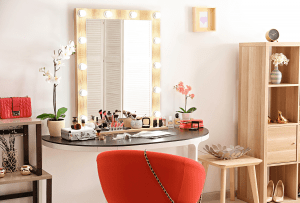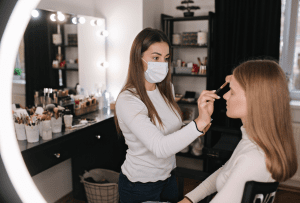
Lighting is a very important factor when it comes to makeup artistry. Good lighting can help to accentuate the features of someone’s face, which is why it is important for makeup artists. In order to be a successful makeup artist, it is important to understand the different types of lighting and how to use them to your advantage. In this article, we’ll discuss why lighting is so important for makeup artists and provide tips for finding the right light for your needs.

One of the most important aspects of makeup is lighting. Makeup artists know that good lighting is key to a flawless makeup application. Good lighting can help make sure that the makeup is applied evenly and that any imperfections are hidden and can help to enhance the beauty of the face. The wrong type of lighting can make your makeup look cakey, streaky, or too dark.
Most makeup artists rely on correct lighting to see the true colors of their makeup palette and to apply makeup evenly. Incorrect lighting can cause shadows and highlights that make the face look different than it does in natural light. Additionally, good lighting can make you look years younger, while bad lighting can make you look tired and old. That’s why it’s important to have an arsenal of different types of lighting when you’re working on someone’s face.

Makeup artists use lighting to enhance their subjects’ features. And when it comes to quality of light for makeup artists, there are two main types that are typically used in this type of work: soft light and hard light. Each type has its own benefits and drawbacks, so it’s important to understand the differences before deciding which is best for your needs.
Soft light is often used to enhance and soften features. It is diffused and comes from a large source, such as the sun or a lamp. Soft light is created by using diffusers to scatter the light from a single source. This produces a softer, more natural look that is often preferred for everyday makeup applications. Hard light can be used to create more defined looks and is harsher and can create more shadows. It is directional and comes from a small source, such as a flashlight.
When it comes to choosing between the two, it really depends on what you want to achieve with your makeup. If you’re looking for a more natural look, soft light is the way to go. However, if you’re going for something more dramatic, hard lighting can be great for creating definition and sharp lines. For makeup artists, it’s important to understand the difference between the two so that you can choose the right type of light for your desired outcome.

When positioning the lights in makeup services, there are three common angles that are used: frontal, 45-degree, and side lighting. Each has its own set of features, benefits, and purposes.
Frontal lighting is the most popular position for lights because it offers the best view of the face. It is often used to achieve an overall glow to the face. Frontal lighting is used to create a natural look and to accentuate the features of the face. It is also good for contouring and highlighting.
45-degree angle lighting is good for contouring the face because it casts shadows that define the shape of the face. It is also used to hide blemishes and wrinkles. It is great for showing off the features of the face and is good for sculpting the face.
Side lighting is used to add depth to the face and to make it look more angular. It is also good for highlighting certain features, such as the eyes or lips.
Different positioning of the lights in makeup service can be used to achieve different effects. Each position has its own benefits and drawbacks so it’s better to know what kind of makeup techniques you are using for your client to emphasize different features of their face.
Lighting is key for makeup application and it is important to adjust it in a room when providing makeup services. Lighting can greatly affect how the makeup looks on a person and the wrong light can wash out your makeup or make it look too harsh. There are three components to lighting that should be considered when arranging lighting for makeup services: brightness, contrast, and color temperature.
Here are some tips for adjusting the lighting in your space to improve your makeup service.
1. Start by adjusting the brightness of the light. The brightness of the light should be adjusted so that it is not too bright or too dark. This will determine how bright or subtle your makeup look will be.
2. Contrast is also important to consider when adjusting the lighting because it can be used to create depth and dimension. Too much contrast can make your makeup look severe, so try to find a happy medium.
3. Finally, color temperature should also be taken into account when setting up the lighting for makeup services. The color temperature of the light should be adjusted to match the person’s skin tone. Cooler temperatures will give a more natural look, while warmer temperatures will create a more dramatic effect.
In conclusion, there are a few different lighting setups that can be used for makeup artists. It is important to choose the right one for the situation. Each setup has its own benefits and drawbacks. The best option for a makeup artist will depend on the type of work they are doing.